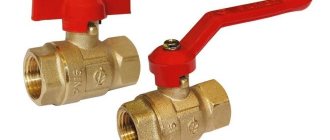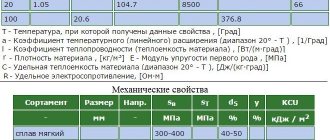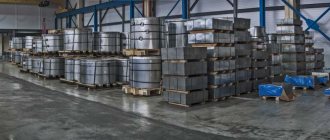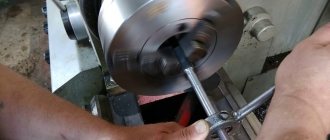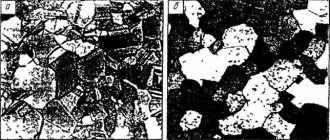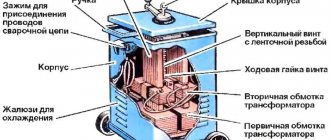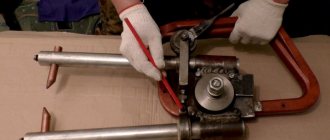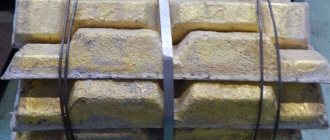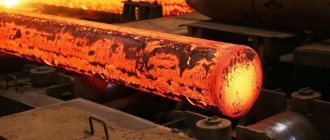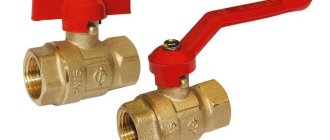Phase state of matter in alloy L63
Alloys are single-phase and two-phase. Two-component alloys, including L63, mainly belong to single-phase structures. When the second phase appears, the mechanical properties of products decrease: fragility and hardness increase, and the ductility of products decreases. For this reason, two-phase a+b brasses are difficult to work with pressure. Single-phase alloys are as well processed by pressure as they are cast into ingots. L63 - contains a small amount of substance in the b-phase, therefore it lends itself well to pressure processing: rolling, deep drawing, embossing, drawing, bending without serious consequences, subject to the processing regime.
This alloy is used to produce:
- Tape L63
- Plate L63
- Pipe L63
- Wire L63
- Circle L63
- Sheet L63
- Rod L63
According to GOST 15527, L63A blanks with antimagnetic properties are also produced. The alloy is suitable for casting, but has limitations in cutting and machining.
Main characteristics
Marking l63 means:
- L - brass;
- 63 is the mass percentage of copper content in this alloy.
Foreign analogues
International marking (exact and closest analogues) of brass L63:
- C27400 - USA;
- C2720 - Japan;
- CuZn37 - Sweden, Austria, Poland;
- CZ108 - England;
- P-CuZn37, P-OT63 - Italy;
- 2.0321CuZn37 - Germany;
- U-Z36, CuZn36 –— France;
- CW507L, CuZn36 - European Union;
- 423213 - Czech Republic.
Chemical composition
According to Interstate Standard 15527-70, brass grade L63 (according to ST SEV 379-76 - CuZn37) belongs to copper-zinc alloys processed by pressure and is simple (double) brass. In accordance with this GOST, material L63 has the following chemical composition:
- copper - 62-65%;
- lead - 0.07%;
- iron - 0.2%;
- antimony - 0.005%;
- bismuth - 0.002%;
- phosphorus - 0.01%.
Total other impurities contain 0.5%. The share of the main alloying component - zinc - accounts for from 37.5 to 34.5%.
The approximate calculated density of brass L63 is 8.5 g/cm.
In materials used in the food industry, the mass fraction of lead should not exceed 0.05%.
The physical and mechanical properties of L63 brass are established by standards for a particular type of product or are specified in an agreement between the manufacturer and the consumer.
Corrosion resistance
All brasses have increased anti-corrosion properties compared to pure copper, but have lower heat and electrical conductivity.
Brass L63 exhibits good anti-corrosion properties under the following conditions:
- in the air, including maritime climates,
- in fresh water
- in slow sea water,
- in an environment of dry halogen gases,
- in dry steam
- in antifreezes, alcohols, freons.
However, there are still a number of limitations. Alloy L63 loses its resistance to corrosion after cutting or machine processing. This is due to disturbances in the crystal structure of the alloy composition and residual stress in the metal. Factors that catalyze the corrosion cracking process are: excess moisture, high temperature, and the presence of sulfur dioxide and ammonia in the atmosphere. To prevent cracking, all products made from L63 are recommended to be annealed at low temperatures.
All brass has limitations on corrosion resistance:
- in contact with fatty acids,
- in mine waters,
- in contact with chlorides and oxidizing solutions,
- in humid saturated vapors, at high pressure,
- in contact with hydrogen sulfide
- and mineral acids.
Products made from thin sheets are most susceptible to corrosion cracking and other manifestations of oxidative processes: tanks, tanks, thin-walled pipes. Nevertheless, with proper use, thin-walled brass products are applicable in many areas of industry.
Physical and mechanical properties
Alloy L63 is double, the structure is single-phase. Compared to copper, it has higher strength, hardness, ductility, elasticity and corrosion resistance. With increasing zinc content, these indicators increase. The greatest practical value for the crystallization of alloys based on copper and zinc are compounds with a zinc content of up to 50%. This number includes brass L63.
Structure
According to the Cu-Zn phase diagram, depending on the composition (zinc content from 0 to 39%), the material is a single-phase brass consisting of an a-solid solution with an equilibrium structure. This amount of zinc allows the alloy to crystallize in an equilibrium state, forming a face-centered cubic lattice (FCC), which achieves its plastic state. An increase in the zinc content in single-phase brasses is accompanied by an increase in their strength and ductility.
Plastic
The relative elongation of the material in the cold state, which characterizes its plasticity, is 55%. In the annealed state, L63 brass is the least ductile. But in the stage of applying cold deformation, plasticity persists for a long period. Higher plastic characteristics of the alloy are noticed when using soft stress state schemes during the deformation of the material, which is taken into account when predicting the possible destruction of the metal.
Susceptibility to processing
L63 is a single-phase alloy, in the b phase, which reduces the mechanical properties of products, contains a negligible amount of substance, and therefore lends itself well to pressure processing at low temperatures:
- minting;
- rolling;
- bending;
- deep drawing;
- drawing
The processed material requires strict adherence to the cooling regime.
Some alloy parameters
Compared to copper, the thermal conductivity and electrical conductivity of L63 brass due to the high zinc content is lower, and the workability is 2 times higher. The impact strength of the alloy is worse than that of L68, but better than that of multi-component brass.
Characteristics of brass L63:
- electrical resistivity – 0.065;
- impact strength – 14;
- machinability – 40%;
- thermal conductivity – 0.25.
The specific gravity of brass L63 is 8.44 g/cm3. The coefficient of friction with lubrication is 0.012, without lubrication - 0.390. Fluid flow - 65 cm, linear shrinkage - 1.77%. Brinnell hardness – 150-160 MPa.
Strength
Alloy L63 has the greatest strength in the cold state. The shear strength is 240 MPa. According to this indicator, the metal is inferior to brass L59-1. The tensile strength (ultimate strength) of double brass L63 in the state of extreme hardening is 735 MPa. The tensile strength of a hard alloy for rolling is in the range of 680-750 MPa, for a soft alloy - 380-450 MPa.
Melting temperature
The temperature range for thermomechanical and heat treatment of this metal is less than for other double brasses. The melting point of brass L63 is 906°C.
Due to the fact that with an increase in the zinc content in the brass alloy, the melting temperature decreases, in order to avoid burnout of the workpieces and their overheating, the temperature of hot processing is reduced to 750-880, and annealing - to 550-660°C.
At the same hot deformation temperature, brass L63 has the lowest values of deformation resistance. The conditional yield strength of the alloy is 700 MPa.
Temperature conditions for processing double brass grade 63:
- casting – 1060-1100°C;
- hot deformation – 650-850;
- beginning of recrystallization – 350-370;
- complete annealing – 660-670°C.
Corrosion resistance
Brass grade L63 in a cold state is subject to corrosion (seasonal) cracking and dezincification (dissolution in an aqueous environment). After the brass dissolves, due to an exchange reaction, copper precipitates from the solution. The copper film has a spongy appearance and creates a galvanic couple with brass, which accelerates the corrosion process. Dezincification occurs more intensively with increasing temperature of the environment and increasing the speed of water movement.
Causes
The main reasons leading to corrosion cracking of alloy L63:
- unfavorable environment (moisture and oxygen content, traces of ammonia, mercury salts, sulfur dioxide);
- the presence of residual tensile stresses in the metal;
Seasonal phenomena (autumn, spring), when air humidity and, accordingly, the ammonia content in it are increased, are considered especially unfavorable in terms of corrosion.
Internal residual stresses in the workpiece are divided into:
- the first kind (zonal), which are caused by the uneven distribution of deformations during pressure treatment of the material and uneven cooling of the workpiece after heat treatment;
- of the second kind, the causes of which are phase and structural transformations in the alloy.
Anti-cracking measures
To avoid corrosion cracking, use:
- low-temperature annealing of brass to reduce residual stress at 240-300°C;
- creation of compressive residual stresses in the outer layers of the workpieces;
carrying out other production activities aimed at reducing the limit of residual tensile stresses in the metal.
Resistance and instability to corrosion
L63 has increased anti-corrosion resistance in the following conditions:
- air environment;
- dry steam;
- fresh and sedentary sea water;
- dry halogen gas;
- alcohol, freon, antifreeze.
After processing on machines or by cutting, the L63 material loses its resistance to corrosion due to disruption of the crystal structure.
The instability of the alloy to corrosion cracking is observed upon contact:
- with mine waters;
- hydrogen sulfide;
- high pressure;
- fatty acids;
- wet saturated steam;
- oxidizing solutions;
- mineral acids;
- chlorides.
Thin-walled products are most susceptible to corrosion. It is not recommended to use L63 alloy in contact with zinc, aluminum and iron to avoid its accelerated destruction.
Semi-finished products from brass L63. Application
L63, as mentioned earlier, is most widely used in all areas of industry.
Wire from this alloy is available in soft, semi-hard and hard states. It is used for the manufacture of rivets, due to the good ductility of this material, it is used as solder, and electrodes for electroerosive machines are produced from high-precision wire.
L63 pipes come in cold-deformed or pressed form and are widely used everywhere, in particular as pipes for boilers.
A wide range of sheet metal products is produced from L63 alloy. The alloy has high ductility and strength compared to Cu. But the best performance in this regard is given by the L68 alloy.
L63 rods are supplied in bulk, in solid, semi-solid, solid state, or pressed, with a diameter from 3 to 180 mm. Among other two-component brasses, this alloy stands out for its highest shear strength, high resistivity and excellent machinability. In terms of impact strength, L63 is inferior to alloys with 68% copper content, but is significantly superior to multicomponent alloys. In terms of shear strength, L63 is inferior to L59-1. The thermal and electrical conductivity of the alloy with 63% Cu is relatively low.
Scope of use
Products made from L63 brass are in demand in the aircraft and automotive industries. Rolled products from this grade of metal occupy a leading position in the production of plumbing and engineering structures.
Tapes, pipes, circles, plates, sheets, rods, wires, containers, and couplings are made from alloy L63. It serves as a raw material for the production of electrodes, design elements, rivets, fittings and furniture structures. Advertising and information signs are also made from it. By themselves, they look attractive, and if desired, they can be further decorated with engraving.
Application
L63 is most effectively used in the production of parts made by deformation, with high requirements for corrosion resistance. It is used to produce boiler pipes, tanks, radiator tapes, electrodes, solder wire, couplings and rivets, decorative elements in design and architecture and other products.
L63 is suitable for casting and machining. Under the same conditions, it exhibits greater strength compared to LS59-1, in the presence of cuts, on products under load, although it is inferior to the latter in terms of machinability by cutting.
Properties L63
Physical properties of L63
| T | E 10- 5 — Modulus of elasticity of the first kind | a 106 — Coefficient of thermal (linear) expansion | r — Density | R 10 9 - Electrical resistivity |
| hail | MPa | 1/Grad | kg/m3 | Ohm m |
| 20 | 1.16 | 8440 | 74 | |
| 100 | 20.5 | ; |
Mechanical properties of L63 at T=20oC
| Assortment | sв | d5 |
| MPa | % | |
| Pressed pipes, GOST 494-90 | 270 | |
| Pressed rod, GOST 2060-2006 | 290 | 33 |
| Solid rod, GOST 2060-2006 | 440 | 11 |
| Soft rod, GOST 2060-2006 | 290 | 44 |
| Hard wire, GOST 1066-90 | 540-930 | |
| Soft wire, GOST 1066-90 | 310-340 | 18-34 |
| Hard wire, GOST 12920-67 | 540-880 | |
| Soft wire, GOST 12920-67 | 310-340 | 26-34 |
| Cold rolled soft strip, GOST 931-90 | 290-400 | 38 |
| Hot rolled strip, GOST 931-90 | 290-390 | 30 |
| Cold rolled hard strip, GOST 931-90 | 410-570 | 8 |
